If you’ve ever been around a child for more than a few seconds, you know they always think that bigger is better:
Adult: “Do you want one small piece of candy or the entire candy bar?”
Child: “The big one!”
Adult: “Do you want the one-bedroom dollhouse or the mansion?”
Child: “The big one!”
Adult: “Do you want the matchbox car or the giant monster truck?”
Child: “The big one!”
But when it comes to matters such as church size, is bigger really better? During a recent study (Global Church Member Study, 2017-18), researchers sought to understand the impact of church size on different aspects of church life. Through the collection of 63,756 surveys, they found that demographically:
- Large churches (attendance of 401 or more) report better education levels (i.e., college/university or graduate level)
- Small churches (attendance of 50 or less) report the highest number of five-person households, while large churches report the highest number of six or more person households.
- Similarly, small churches report the highest number of five-person households with all members observing the Sabbath, and large churches reported the largest number of six or more person households with all members observing the Sabbath.
- Small churches report the highest number of first-generation Adventists, while medium churches (attendance of 51-400) reported similarly high numbers of second, third-, and fourth-generation Adventists. Large churches have the highest number of fifth-generation Adventists.
Congregational Differences by Church Size
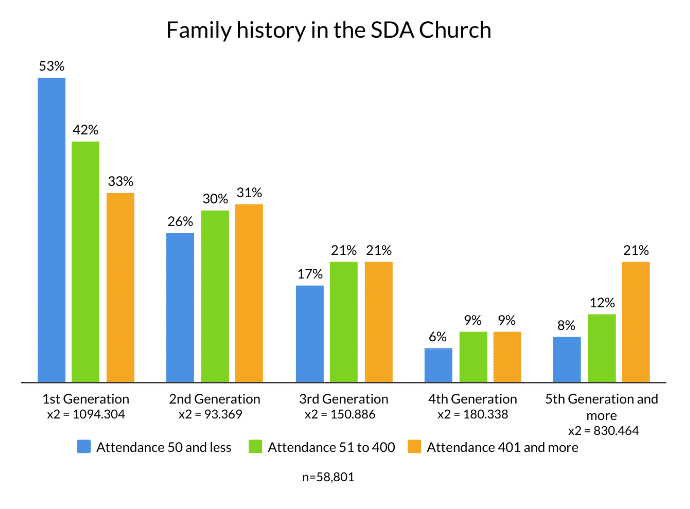
Church satisfaction was also studied. The data showed that attendees of larger churches are more satisfied overall with their local church, while small churches were the least satisfied.
Larger Churches More Satisfied…
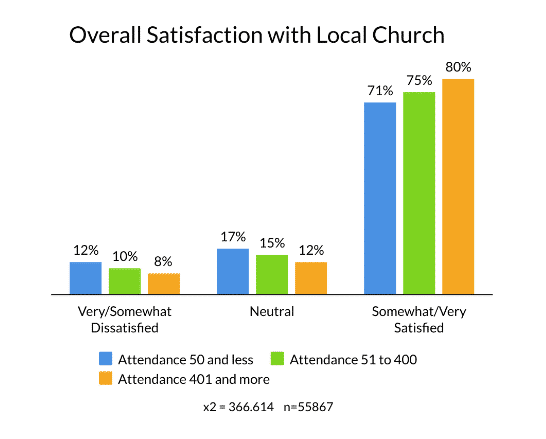
Some interesting trends emerged when it came to religious routines–specifically those practiced in members’ family of origin. Those who attend large churches were more likely to habitually praying before meals (78.5%), have morning or evening worship with one or more parents (57.4%), and attend church regularly with one or both parents (75.7%). Additionally, Adventist education was most valued by families of those who attended large churches (62.8%). Since large churches have more members with a longer history with the Adventist church, these findings seem to be a natural outcome. However, such factors in larger congregations as the attractiveness of church services, friends from the same age group for all members of the family, different approaches of discipleship, and a bigger number of people received Adventist education can contribute to these religious family practices and overall satisfaction.
Those who attend small churches (attendance of 50 and less) reported the lowest practice of religious routines in their family of origin. Adventist education was also of least importance to those in small churches. This may be due to contextual factors (Adventist education not available, not accessible, not affordable). Also, this may also be explained by the fact that a bigger number of the first-generation Adventists attend smaller congregations.
Congregational Differences by Church Size
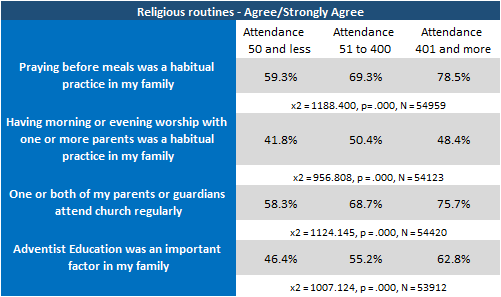
Church size even impacted respondents’ likeliness to remain in the Adventist Church. When asked how probable it was that they would continue their SDA membership, those who attended a large church were most confident about remaining in the Church (95.2% somewhat likely/very likely), while those in small churches were slightly less optimistic about doing so (91.7% somewhat likely/very likely).
Congregational Differences by Church Size
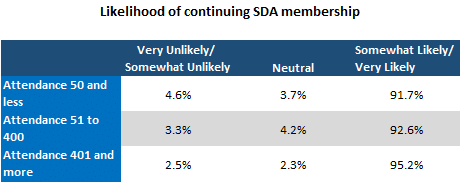
Finally, those who attend large churches are more likely to be dissatisfied by the status quo; they showed a slightly greater desire to be involved in evangelistic outreach, both personally and as local church as a whole, as well as greater desire for their local church to be involved in meeting the needs of the local community. At the same time, members of large churches desire for their churches to be more caring for and nurturing members.
Larger Churches Less Satisfied…
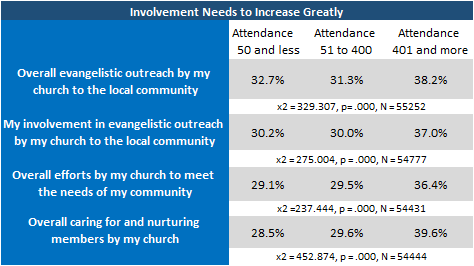
What is average attendance in your congregation? Does your church share any listed characteristics of this particular church size?
While Adventists who are members of large churches report the greatest satisfaction with their local church in general, with members of smaller churches more likely to be satisfied on particular metrics, it is important to note that, regardless of the local congregation’s size, most members are happy with their church family. Whether a congregation is small, large, or medium-sized, it will have strengths and weaknesses. But most of all, regardless of size, it will be what each church member makes it. In 2020, make it your business to get involved!
For more data on church size and member characteristics, commitment, and satisfaction, check out the following presentation by Dr. Petr Cincala, Director of the Institute of Church Ministry:
Church Size and Member Characteristics, Commitment, and Satisfaction
For more data on the 2018 GCMS, look at the following presentation by Dr. David Trim from the Office of Archives, Statistics, and Research:
2018 Annual Council–Global Church Member Survey Data Report
Creado en colaboración con el Instituto del Ministerio de la Iglesia (Institute of Church Ministry).
Published by ASTR

